Module 4 Unit 2 Does Lingling like oranges? 教案(含反思)
文档属性
| 名称 | Module 4 Unit 2 Does Lingling like oranges? 教案(含反思) | 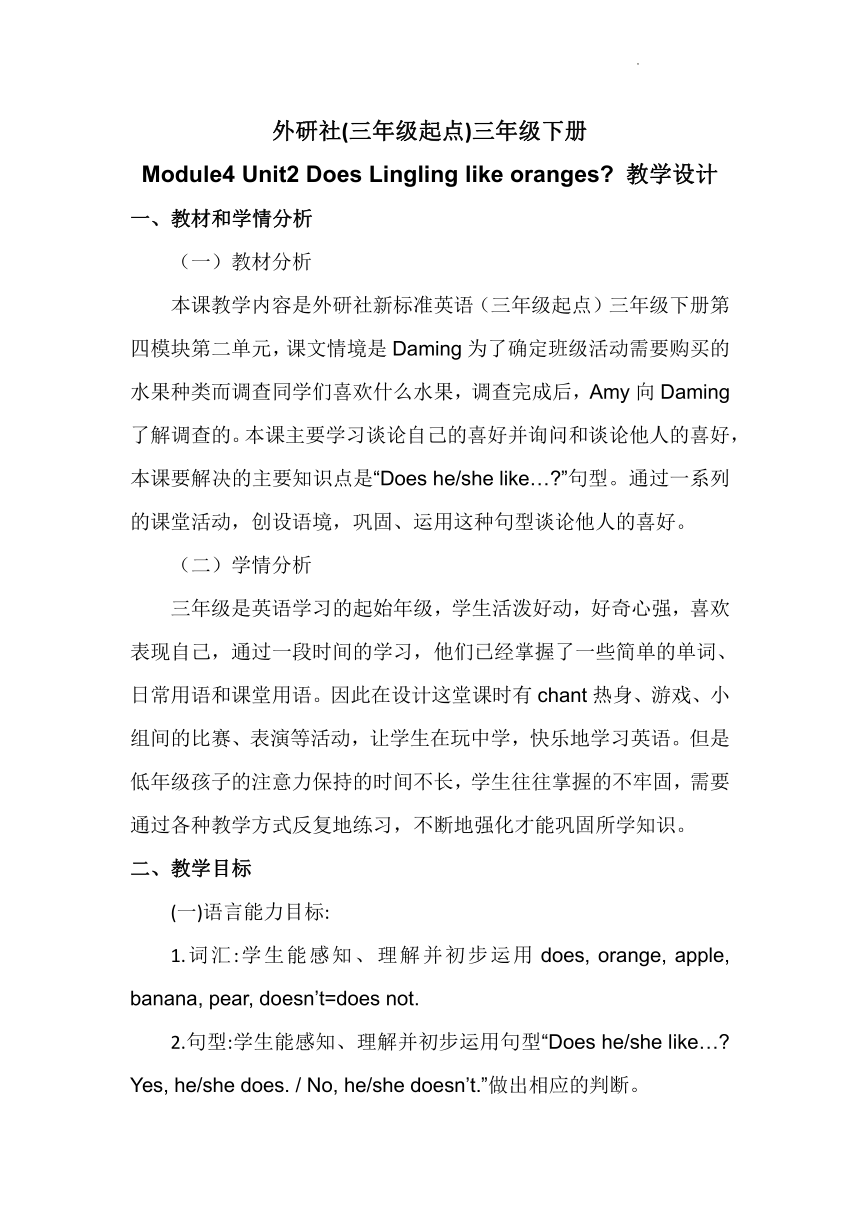 | |
| 格式 | zip | ||
| 文件大小 | 374.6KB | ||
| 资源类型 | 教案 | ||
| 版本资源 | 外研版(三年级起点) | ||
| 科目 | 英语 | ||
| 更新时间 | 2022-05-26 11:02:12 | ||
图片预览

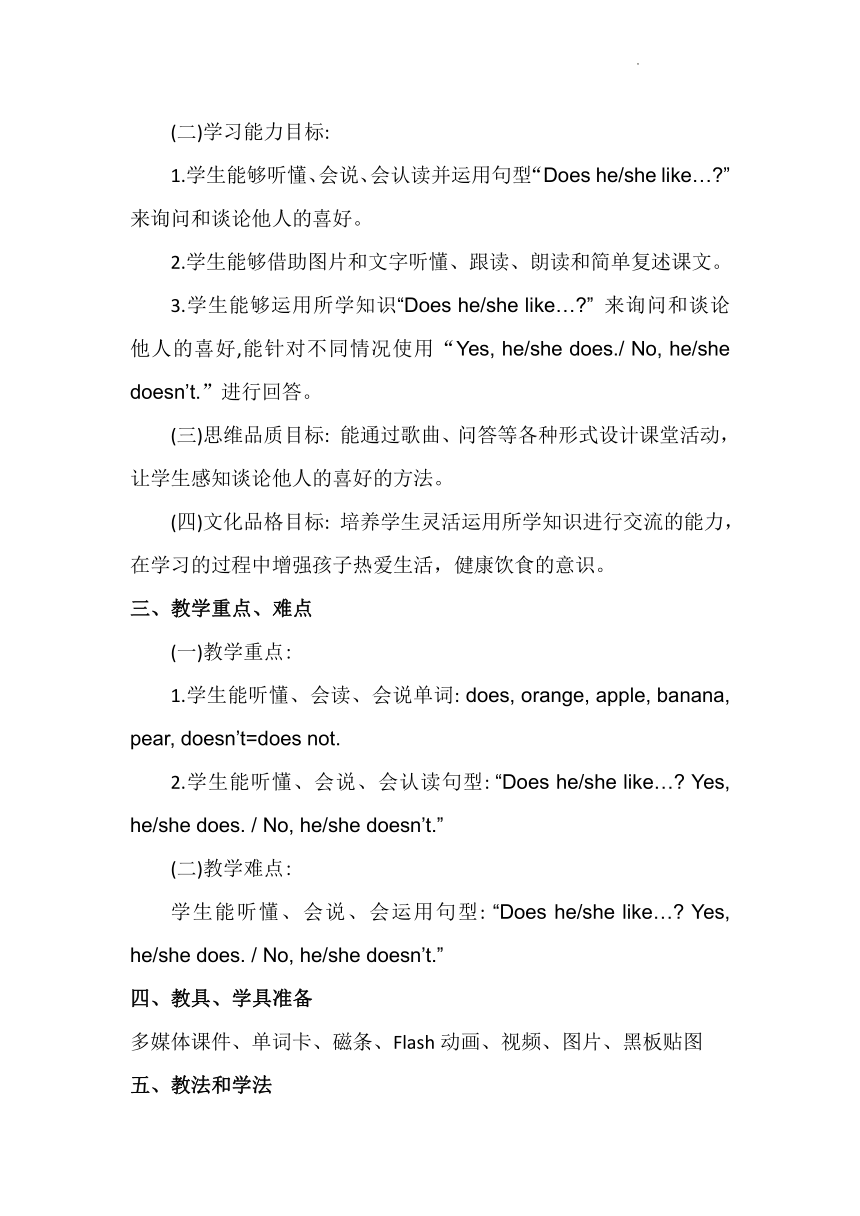
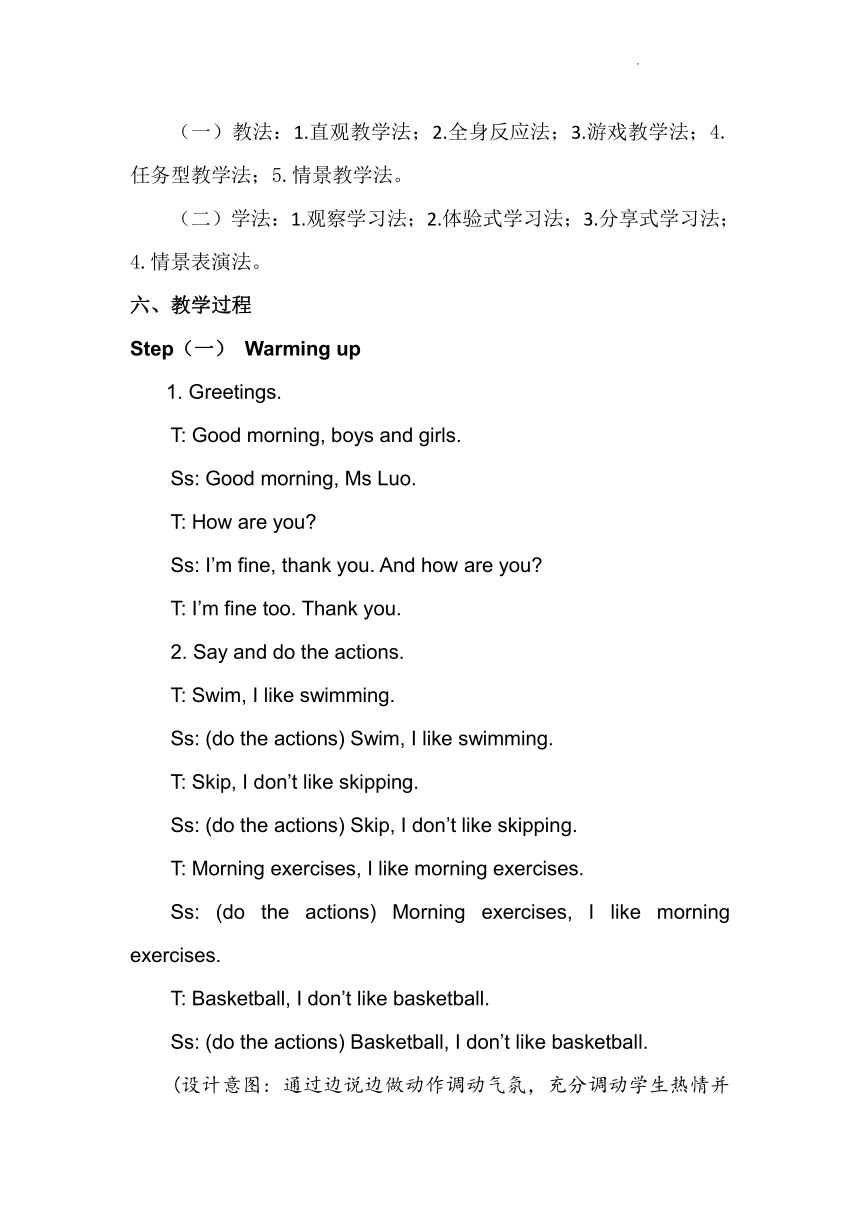
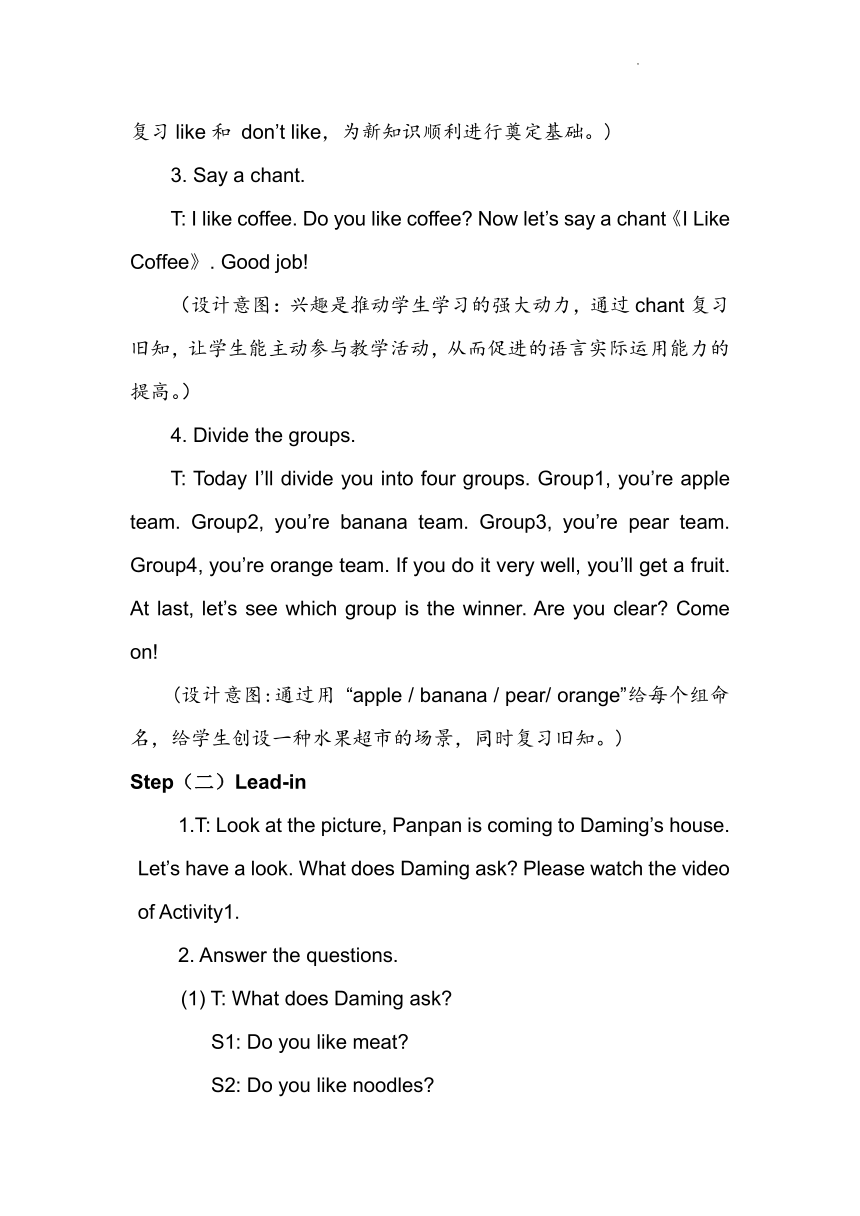
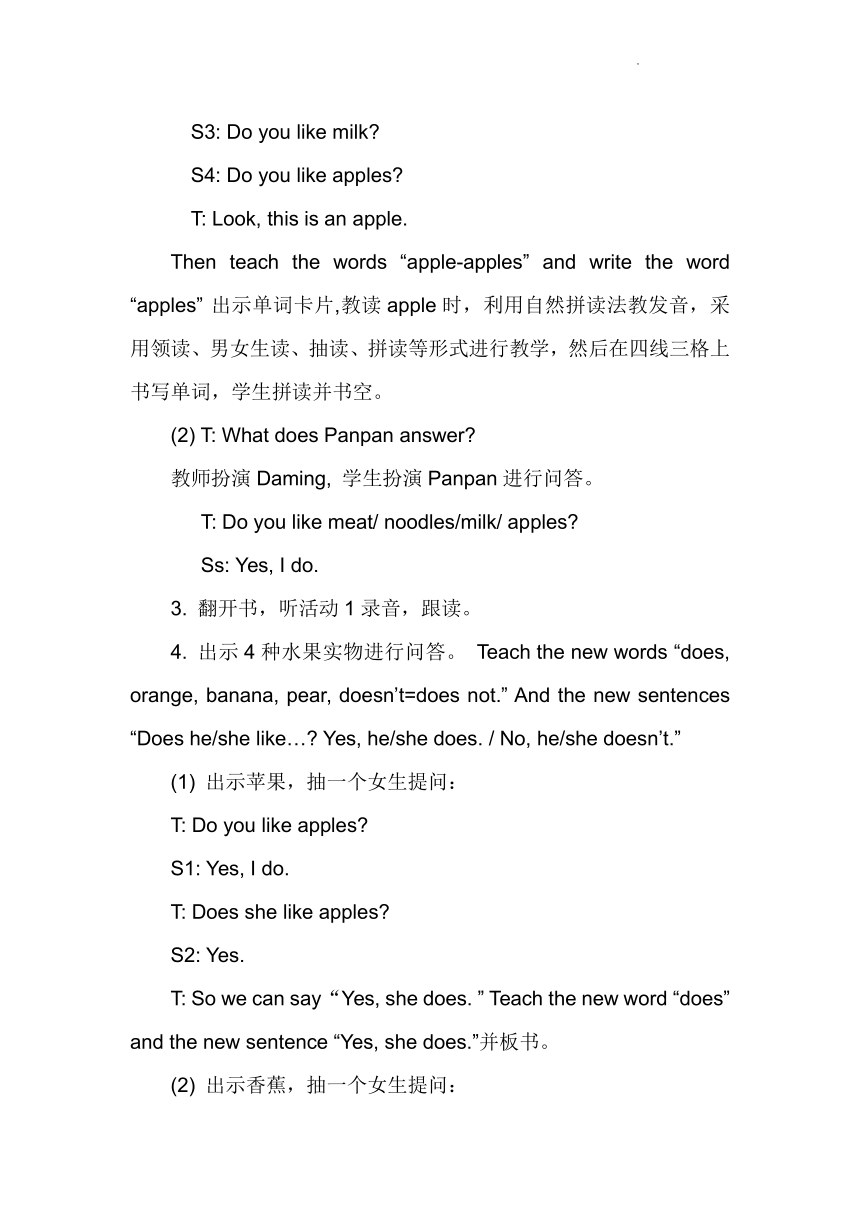
文档简介
外研社(三年级起点)三年级下册
Module4 Unit2 Does Lingling like oranges 教学设计
一、教材和学情分析
(一)教材分析
本课教学内容是外研社新标准英语(三年级起点)三年级下册第四模块第二单元,课文情境是Daming为了确定班级活动需要购买的水果种类而调查同学们喜欢什么水果,调查完成后,Amy向Daming了解调查的。本课主要学习谈论自己的喜好并询问和谈论他人的喜好,本课要解决的主要知识点是“Does he/she like… ”句型。通过一系列的课堂活动,创设语境,巩固、运用这种句型谈论他人的喜好。
(二)学情分析
三年级是英语学习的起始年级,学生活泼好动,好奇心强,喜欢表现自己,通过一段时间的学习,他们已经掌握了一些简单的单词、日常用语和课堂用语。因此在设计这堂课时有chant热身、游戏、小组间的比赛、表演等活动,让学生在玩中学,快乐地学习英语。但是低年级孩子的注意力保持的时间不长,学生往往掌握的不牢固,需要通过各种教学方式反复地练习,不断地强化才能巩固所学知识。
二、教学目标
(一)语言能力目标:
1.词汇:学生能感知、理解并初步运用does, orange, apple, banana, pear, doesn’t=does not.
2.句型:学生能感知、理解并初步运用句型“Does he/she like… Yes, he/she does. / No, he/she doesn’t.”做出相应的判断。
(二)学习能力目标:
1.学生能够听懂、会说、会认读并运用句型“Does he/she like… ”来询问和谈论他人的喜好。
2.学生能够借助图片和文字听懂、跟读、朗读和简单复述课文。
3.学生能够运用所学知识“Does he/she like… ” 来询问和谈论他人的喜好,能针对不同情况使用“Yes, he/she does./ No, he/she doesn’t.”进行回答。
(三)思维品质目标: 能通过歌曲、问答等各种形式设计课堂活动,让学生感知谈论他人的喜好的方法。
(四)文化品格目标: 培养学生灵活运用所学知识进行交流的能力,在学习的过程中增强孩子热爱生活,健康饮食的意识。
三、教学重点、难点
(一)教学重点:
1.学生能听懂、会读、会说单词: does, orange, apple, banana, pear, doesn’t=does not.
2.学生能听懂、会说、会认读句型: “Does he/she like… Yes, he/she does. / No, he/she doesn’t.”
(二)教学难点:
学生能听懂、会说、会运用句型: “Does he/she like… Yes, he/she does. / No, he/she doesn’t.”
四、教具、学具准备
多媒体课件、单词卡、磁条、Flash动画、视频、图片、黑板贴图
五、教法和学法
(一)教法:1.直观教学法;2.全身反应法;3.游戏教学法;4.任务型教学法;5.情景教学法。
(二)学法:1.观察学习法;2.体验式学习法;3.分享式学习法;4.情景表演法。
六、教学过程
Step(一) Warming up
1. Greetings.
T: Good morning, boys and girls.
Ss: Good morning, Ms Luo.
T: How are you
Ss: I’m fine, thank you. And how are you
T: I’m fine too. Thank you.
2. Say and do the actions.
T: Swim, I like swimming.
Ss: (do the actions) Swim, I like swimming.
T: Skip, I don’t like skipping.
Ss: (do the actions) Skip, I don’t like skipping.
T: Morning exercises, I like morning exercises.
Ss: (do the actions) Morning exercises, I like morning exercises.
T: Basketball, I don’t like basketball.
Ss: (do the actions) Basketball, I don’t like basketball.
(设计意图: 通过边说边做动作调动气氛,充分调动学生热情并复习like和 don’t like,为新知识顺利进行奠定基础。)
3. Say a chant.
T: I like coffee. Do you like coffee Now let’s say a chant《I Like Coffee》. Good job!
(设计意图:兴趣是推动学生学习的强大动力,通过chant复习旧知,让学生能主动参与教学活动,从而促进的语言实际运用能力的提高。)
4. Divide the groups.
T: Today I’ll divide you into four groups. Group1, you’re apple team. Group2, you’re banana team. Group3, you’re pear team. Group4, you’re orange team. If you do it very well, you’ll get a fruit. At last, let’s see which group is the winner. Are you clear Come on!
(设计意图:通过用 “apple / banana / pear/ orange”给每个组命名,给学生创设一种水果超市的场景,同时复习旧知。)
Step(二)Lead-in
1.T: Look at the picture, Panpan is coming to Daming’s house. Let’s have a look. What does Daming ask Please watch the video of Activity1.
2. Answer the questions.
(1) T: What does Daming ask
S1: Do you like meat
S2: Do you like noodles
S3: Do you like milk
S4: Do you like apples
T: Look, this is an apple.
Then teach the words “apple-apples” and write the word “apples” 出示单词卡片,教读apple时,利用自然拼读法教发音,采用领读、男女生读、抽读、拼读等形式进行教学,然后在四线三格上书写单词,学生拼读并书空。
(2) T: What does Panpan answer
教师扮演Daming, 学生扮演Panpan进行问答。
T: Do you like meat/ noodles/milk/ apples
Ss: Yes, I do.
3. 翻开书,听活动1录音,跟读。
4. 出示4种水果实物进行问答。 Teach the new words “does, orange, banana, pear, doesn’t=does not.” And the new sentences “Does he/she like… Yes, he/she does. / No, he/she doesn’t.”
(1) 出示苹果,抽一个女生提问:
T: Do you like apples
S1: Yes, I do.
T: Does she like apples
S2: Yes.
T: So we can say“Yes, she does. ” Teach the new word “does” and the new sentence “Yes, she does.”并板书。
(2) 出示香蕉,抽一个女生提问:
T: Do you like bananas Teach the new word “banana-bananas” 利用自然拼读法教发音,采用领读、分组读、抽读、开火车等形式进行教学,然后在四线三格上书写单词,学生拼读并书空。
S1: No, I don’t.
T: Does she like bananas
S2: No.
T: So we can say“No, she doesn’t.” Teach the new word “doesn’t=does not” and the new sentence “No, she doesn’t.”并板书。
(3) 出示梨,抽一个男生提问:
T: Do you like pears Teach the new word “pear-pears” 利用自然拼读法教发音,采用领读、大小声读、抽读等形式进行教学,然后在四线三格上书写单词,学生拼读并书空。
S1: Yes, I do.
T: Does he like pears
S2: Yes.
T: So we can say“Yes, he does. ” Teach the new sentence “Yes, he does.”并板书。
(4)抽一个男生提问:
T:(出示一张橙色的卡纸)What colour
Ss: It’s orange.
T: Do you like orange
Ss: Yes, I do.
T:(出示一个桔子)抽一个男生提问:It’s an orange. Do you like oranges
S1: No, I don’t.
T: Does he like apples
S2: No, he doesn’t.
T: You’re right. Teach the new sentence “No, he doesn’t.”并板书。
(设计意图: 通过先问一个孩子“Do you like … ”再询问另一个孩子“Does he/she like… ”很自然的转换成第三人称的问与答 “Yes, he/she does. / No, he/she doesn’t.”让学生轻松理解这个句型。)
5. Today we’re going to learn Module4 Unit2 Does Lingling like oranges (板书课题)
Step(三)Presentation
1. Daming, Lingling and Sam, they’ re going to have a picnic on Sunday. So Daming does a survey. Let’s watch the video of activity 2. Answer: Does Lingling like oranges Yes, she does.
2. 翻开书,听活动2录音,跟读。
3. Listen again and answer the questions. 学生听录音,找出答案,并划上横线。再抽生回答,并说出根据哪句话回答的。
Q1. Does Sam like bananas
Q2. Does Sam like pears
Q3. Does Lingling like oranges
Q4. Does Lingling like apples
4.学生根据课文内容选择图片,并说句子。
Sam likes_________,
he doesn’t like__________.
Lingling likes_________,
she doesn’t like__________.
5. Read the text together, then act it out.
(设计意图: 通过分图学习,把新单词学习融入情景中,学生能更好的掌握,培养学生的思维模式。)
Step(四)Practice
1. 快闪出示单词或图片,学生齐读出来,教师再举例说:I like swimming. I don’t like coffee.然后让学生两人一组进行讨论交流自己喜欢和不喜欢的。
(设计意图:快闪复习新旧知识,把新旧知识融合在一起操练,学生结合实际能很好的输出语言。)
2. Read, choose, copy the words and ask in pairs.
(读短文,根据图片选择正确的单词写下来,同桌仿照例句问答)
(设计意图:通过语篇训练,让学生的知识更系统化。让学生写单词练习了书写,提问能有效地操练“Does he/she like… Yes, he/she does. / No, he/she doesn’t.”句型。)
Step(五)Emotional education.
Watch a video of a Chinese food, let the students know: Don’t be picky about your food! Because they’re good for our health!
(设计意图:通过中国美食的视频,让孩子们感受食物的魅力,引出Don’t be picky about your food! Because they’re good for our health!)
Step(六)Summary
1. Retell the text according to the blackboard.
2. Let’s have a look. Which group is the winner
Step(七)Homework.
Read the text three times .
2. do a survey to find out what sport Mum and Dad like to do.
七、板书设计:
八、教学反思
本节课我注重学生基础知识的学习和掌握,利用上一个单元已经学习了的食物和运动,运用chant的形式引入Do you like… 句型的复习。在新单词的教学中注重听说读写的训练,让学生用自然拼读法学习单词的读音,拼读单词并书空记住单词的书写格式,通过领读、齐读、男女生读、分组读、大小声读、开火车读、拼读等多种形式来检测学生对所学内容的掌握,尽量让每一个孩子都敢于开口说,并及时鼓励。
在教学过程中深挖教材,适时开展了健康饮食方面的情感教育,培养学生的良好文化品格。
通过这节课,孩子们基本上能用“Does he/she like… ”询问他人的喜好,同时用“Yes, he/she does. / No, he/she doesn’t.”进行回答。同时小组间通过谈论自己与他人的喜好,扮演Daming, Lingling, Amy,积极参与到活动中,通过形象有趣的活动巩固练习,也培养了孩子们小组合作的能力,让学生充分理解并能运用“Does he/she like… Yes, he/she does. / No, he/she doesn’t.”,从而突破了重点和难点。也让学生不断在体验、参与中巩固了所学的新单词。
Module4 Unit2 Does Lingling like oranges 教学设计
一、教材和学情分析
(一)教材分析
本课教学内容是外研社新标准英语(三年级起点)三年级下册第四模块第二单元,课文情境是Daming为了确定班级活动需要购买的水果种类而调查同学们喜欢什么水果,调查完成后,Amy向Daming了解调查的。本课主要学习谈论自己的喜好并询问和谈论他人的喜好,本课要解决的主要知识点是“Does he/she like… ”句型。通过一系列的课堂活动,创设语境,巩固、运用这种句型谈论他人的喜好。
(二)学情分析
三年级是英语学习的起始年级,学生活泼好动,好奇心强,喜欢表现自己,通过一段时间的学习,他们已经掌握了一些简单的单词、日常用语和课堂用语。因此在设计这堂课时有chant热身、游戏、小组间的比赛、表演等活动,让学生在玩中学,快乐地学习英语。但是低年级孩子的注意力保持的时间不长,学生往往掌握的不牢固,需要通过各种教学方式反复地练习,不断地强化才能巩固所学知识。
二、教学目标
(一)语言能力目标:
1.词汇:学生能感知、理解并初步运用does, orange, apple, banana, pear, doesn’t=does not.
2.句型:学生能感知、理解并初步运用句型“Does he/she like… Yes, he/she does. / No, he/she doesn’t.”做出相应的判断。
(二)学习能力目标:
1.学生能够听懂、会说、会认读并运用句型“Does he/she like… ”来询问和谈论他人的喜好。
2.学生能够借助图片和文字听懂、跟读、朗读和简单复述课文。
3.学生能够运用所学知识“Does he/she like… ” 来询问和谈论他人的喜好,能针对不同情况使用“Yes, he/she does./ No, he/she doesn’t.”进行回答。
(三)思维品质目标: 能通过歌曲、问答等各种形式设计课堂活动,让学生感知谈论他人的喜好的方法。
(四)文化品格目标: 培养学生灵活运用所学知识进行交流的能力,在学习的过程中增强孩子热爱生活,健康饮食的意识。
三、教学重点、难点
(一)教学重点:
1.学生能听懂、会读、会说单词: does, orange, apple, banana, pear, doesn’t=does not.
2.学生能听懂、会说、会认读句型: “Does he/she like… Yes, he/she does. / No, he/she doesn’t.”
(二)教学难点:
学生能听懂、会说、会运用句型: “Does he/she like… Yes, he/she does. / No, he/she doesn’t.”
四、教具、学具准备
多媒体课件、单词卡、磁条、Flash动画、视频、图片、黑板贴图
五、教法和学法
(一)教法:1.直观教学法;2.全身反应法;3.游戏教学法;4.任务型教学法;5.情景教学法。
(二)学法:1.观察学习法;2.体验式学习法;3.分享式学习法;4.情景表演法。
六、教学过程
Step(一) Warming up
1. Greetings.
T: Good morning, boys and girls.
Ss: Good morning, Ms Luo.
T: How are you
Ss: I’m fine, thank you. And how are you
T: I’m fine too. Thank you.
2. Say and do the actions.
T: Swim, I like swimming.
Ss: (do the actions) Swim, I like swimming.
T: Skip, I don’t like skipping.
Ss: (do the actions) Skip, I don’t like skipping.
T: Morning exercises, I like morning exercises.
Ss: (do the actions) Morning exercises, I like morning exercises.
T: Basketball, I don’t like basketball.
Ss: (do the actions) Basketball, I don’t like basketball.
(设计意图: 通过边说边做动作调动气氛,充分调动学生热情并复习like和 don’t like,为新知识顺利进行奠定基础。)
3. Say a chant.
T: I like coffee. Do you like coffee Now let’s say a chant《I Like Coffee》. Good job!
(设计意图:兴趣是推动学生学习的强大动力,通过chant复习旧知,让学生能主动参与教学活动,从而促进的语言实际运用能力的提高。)
4. Divide the groups.
T: Today I’ll divide you into four groups. Group1, you’re apple team. Group2, you’re banana team. Group3, you’re pear team. Group4, you’re orange team. If you do it very well, you’ll get a fruit. At last, let’s see which group is the winner. Are you clear Come on!
(设计意图:通过用 “apple / banana / pear/ orange”给每个组命名,给学生创设一种水果超市的场景,同时复习旧知。)
Step(二)Lead-in
1.T: Look at the picture, Panpan is coming to Daming’s house. Let’s have a look. What does Daming ask Please watch the video of Activity1.
2. Answer the questions.
(1) T: What does Daming ask
S1: Do you like meat
S2: Do you like noodles
S3: Do you like milk
S4: Do you like apples
T: Look, this is an apple.
Then teach the words “apple-apples” and write the word “apples” 出示单词卡片,教读apple时,利用自然拼读法教发音,采用领读、男女生读、抽读、拼读等形式进行教学,然后在四线三格上书写单词,学生拼读并书空。
(2) T: What does Panpan answer
教师扮演Daming, 学生扮演Panpan进行问答。
T: Do you like meat/ noodles/milk/ apples
Ss: Yes, I do.
3. 翻开书,听活动1录音,跟读。
4. 出示4种水果实物进行问答。 Teach the new words “does, orange, banana, pear, doesn’t=does not.” And the new sentences “Does he/she like… Yes, he/she does. / No, he/she doesn’t.”
(1) 出示苹果,抽一个女生提问:
T: Do you like apples
S1: Yes, I do.
T: Does she like apples
S2: Yes.
T: So we can say“Yes, she does. ” Teach the new word “does” and the new sentence “Yes, she does.”并板书。
(2) 出示香蕉,抽一个女生提问:
T: Do you like bananas Teach the new word “banana-bananas” 利用自然拼读法教发音,采用领读、分组读、抽读、开火车等形式进行教学,然后在四线三格上书写单词,学生拼读并书空。
S1: No, I don’t.
T: Does she like bananas
S2: No.
T: So we can say“No, she doesn’t.” Teach the new word “doesn’t=does not” and the new sentence “No, she doesn’t.”并板书。
(3) 出示梨,抽一个男生提问:
T: Do you like pears Teach the new word “pear-pears” 利用自然拼读法教发音,采用领读、大小声读、抽读等形式进行教学,然后在四线三格上书写单词,学生拼读并书空。
S1: Yes, I do.
T: Does he like pears
S2: Yes.
T: So we can say“Yes, he does. ” Teach the new sentence “Yes, he does.”并板书。
(4)抽一个男生提问:
T:(出示一张橙色的卡纸)What colour
Ss: It’s orange.
T: Do you like orange
Ss: Yes, I do.
T:(出示一个桔子)抽一个男生提问:It’s an orange. Do you like oranges
S1: No, I don’t.
T: Does he like apples
S2: No, he doesn’t.
T: You’re right. Teach the new sentence “No, he doesn’t.”并板书。
(设计意图: 通过先问一个孩子“Do you like … ”再询问另一个孩子“Does he/she like… ”很自然的转换成第三人称的问与答 “Yes, he/she does. / No, he/she doesn’t.”让学生轻松理解这个句型。)
5. Today we’re going to learn Module4 Unit2 Does Lingling like oranges (板书课题)
Step(三)Presentation
1. Daming, Lingling and Sam, they’ re going to have a picnic on Sunday. So Daming does a survey. Let’s watch the video of activity 2. Answer: Does Lingling like oranges Yes, she does.
2. 翻开书,听活动2录音,跟读。
3. Listen again and answer the questions. 学生听录音,找出答案,并划上横线。再抽生回答,并说出根据哪句话回答的。
Q1. Does Sam like bananas
Q2. Does Sam like pears
Q3. Does Lingling like oranges
Q4. Does Lingling like apples
4.学生根据课文内容选择图片,并说句子。
Sam likes_________,
he doesn’t like__________.
Lingling likes_________,
she doesn’t like__________.
5. Read the text together, then act it out.
(设计意图: 通过分图学习,把新单词学习融入情景中,学生能更好的掌握,培养学生的思维模式。)
Step(四)Practice
1. 快闪出示单词或图片,学生齐读出来,教师再举例说:I like swimming. I don’t like coffee.然后让学生两人一组进行讨论交流自己喜欢和不喜欢的。
(设计意图:快闪复习新旧知识,把新旧知识融合在一起操练,学生结合实际能很好的输出语言。)
2. Read, choose, copy the words and ask in pairs.
(读短文,根据图片选择正确的单词写下来,同桌仿照例句问答)
(设计意图:通过语篇训练,让学生的知识更系统化。让学生写单词练习了书写,提问能有效地操练“Does he/she like… Yes, he/she does. / No, he/she doesn’t.”句型。)
Step(五)Emotional education.
Watch a video of a Chinese food, let the students know: Don’t be picky about your food! Because they’re good for our health!
(设计意图:通过中国美食的视频,让孩子们感受食物的魅力,引出Don’t be picky about your food! Because they’re good for our health!)
Step(六)Summary
1. Retell the text according to the blackboard.
2. Let’s have a look. Which group is the winner
Step(七)Homework.
Read the text three times .
2. do a survey to find out what sport Mum and Dad like to do.
七、板书设计:
八、教学反思
本节课我注重学生基础知识的学习和掌握,利用上一个单元已经学习了的食物和运动,运用chant的形式引入Do you like… 句型的复习。在新单词的教学中注重听说读写的训练,让学生用自然拼读法学习单词的读音,拼读单词并书空记住单词的书写格式,通过领读、齐读、男女生读、分组读、大小声读、开火车读、拼读等多种形式来检测学生对所学内容的掌握,尽量让每一个孩子都敢于开口说,并及时鼓励。
在教学过程中深挖教材,适时开展了健康饮食方面的情感教育,培养学生的良好文化品格。
通过这节课,孩子们基本上能用“Does he/she like… ”询问他人的喜好,同时用“Yes, he/she does. / No, he/she doesn’t.”进行回答。同时小组间通过谈论自己与他人的喜好,扮演Daming, Lingling, Amy,积极参与到活动中,通过形象有趣的活动巩固练习,也培养了孩子们小组合作的能力,让学生充分理解并能运用“Does he/she like… Yes, he/she does. / No, he/she doesn’t.”,从而突破了重点和难点。也让学生不断在体验、参与中巩固了所学的新单词。
同课章节目录
- Module 1
- Unit 1 It's the ABC song.
- Unit 2 My favourite colour is yellow.
- Module 2
- Unit 1 They are monkeys.
- Unit 2 The man is short.
- Module 3
- Unit 1 I like football.
- Unit 2 I don't like riding my bike.
- Module 4
- Unit 1 Do you like meat?
- Unit 2 Does Lingling like oranges?
- Module 5
- Unit 1 She goes to school on Mondays.
- Unit 2 Does your mum go to work on Saturdays?
- Module 6
- Unit 1 What do you do on Sundays?
- Unit 2 What does Lingling have at school?
- Module 7
- Unit 1 We fly kites in spring.
- Unit 2 It's warm today.
- Module 8
- Unit 1 It's on your desk.
- Unit 2 Daming flies a kite in the park.
- Module 9
- Unit 1 I've got a new book.
- Unit 2 Has Amy got a bike?
- Review Module
- Unit 1
- Unit 2
- Module 10
- Unit 1 Here's a red hat.
- Unit 2 She's got an orange sweater.
